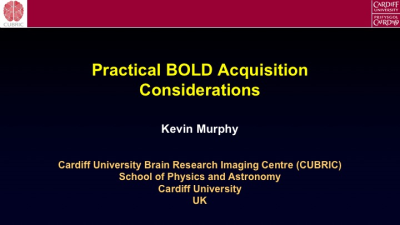|
Weekend Educational Course
Introduction to fMRI: Basics & Applications |
|
Introduction to fMRI: Basics & Applications: Part 1
Weekend Course
ORGANIZERS: Richard Buxton, Benedikt Poser, Joshua Shimony
Saturday, 16 June 2018
| N03 |
08:00 - 09:40 |
Moderators: Jonathan Polimeni, Joshua Shimony |
Skill Level: Basic
Session Number: WE-04A
Overview
This session will cover introductory and intermediate topics in BOLD fMRI acquisition and analysis including basic task based and resting state fMRI analysis using general linear model and data-driven analysis approaches, respectively, as well as combined measurement and analysis of BOLD and perfusion and EEG/MEG data.
Target Audience
Cognitive neuroscientists, neuroradiologists, clinicians and imaging scientists who currently utilize fMRI and for MR physicists and engineers developing new fMRI methodologies.
Educational Objectives
As a result of attending this course, participants should be able to:
-Explain the physiological basis of the BOLD signal;
-Discuss basic BOLD data acquisition considerations;
-Describe how to perform GLM as well as data driven analyses of fMRI data;
-Illustrate the static and dynamic factors that give rise to observed functional connectivity patterns;
-Employ network analytic approaches to functional connectivity data;
-Discuss clinical applications of BOLD fMRI in activation mapping as well as a tool in psychiatric applications;
-Explain the acquisition and analysis, and applications of, simultaneous BOLD+ASL sampling; and
-Describe the challenges of combining BOLD fMRI with electrophysiological measurements.
08:00
|
 |
 BOLD Signal Physiology BOLD Signal Physiology
Nicholas Blockley
To understand the strengths and limitations of functional MRI we must understand the interaction between the physiology of the brain and the physics of the measured signal. In this talk I will introduce the major physiological drivers of the Blood Oxygenation Level Dependent (BOLD) effect and describe how they affect the MRI signal. We can then use this knowledge to consider how stimulus evoked changes in the BOLD signal can be quantified as changes in oxygen metabolism. Whilst the BOLD signal is considered to be complex, through this understanding, we can observe it provides a rich source of physiological information.
|
08:25
|
 |
 Practical BOLD Acquisition Consideration Practical BOLD Acquisition Consideration
Kevin Murphy
In this educational course, we will explain basic BOLD scanning parameters; what they mean and how they interact with each other. We will discuss ways to improve BOLD time series quality using external recordings of physiology. Finally, we will touch on complementary MRI sequences that can further denoise BOLD fMRI time series.
|
08:50
|
|
 Basic Analysis of Task-Based fMRI Basic Analysis of Task-Based fMRI
Susan Francis
The general linear model (GLM) is one of the most commonly used methods to analyse task-based fMRI data. This talk outlines the basic concepts of the GLM, how it is used to study block and event-related paradigms and associated statistical analysis, as well as some example applications. The talk will then describe some limitations of a GLM, and briefly outline alternative methods to study task-based fMRI paradigms, such as the phase-encoding or travelling-wave method, and independent component analysis.
|
09:15
|
|
 Introduction: Resting-State Functional Connectivity Introduction: Resting-State Functional Connectivity
Jonathan Power
"Functional connectivity" or "resting state" MRI has become commonplace in neuroscience over the last decade, and is increasingly used for clinical studies. This talk introduces some of the central concepts and findings in resting state fMRI. Earlier talks will cover fMRI data acquisition, this talk will mainly discuss data analysis and interpretation. This talk will open by introducing a convenient way to visualize fMRI scans, and then will use this approach to visually fractionate resting state fMRI data (via multi-echo analyses) into non-BOLD and BOLD signals. Only BOLD signals are typically thought to be of interest, but both kinds of signals are prevalent in fMRI scans, and both kinds of signals correlate with cognitive and behavioral variables of interest, making it important to recognize the signatures of each kind of signal. We will discuss the spatial and temporal manifestations of these signals and illustrate how these signals influence functional connectivity properties. We will illustrate how individual denoising techniques remove particular kinds of signals, and that no single denoising technique removes all unwanted signals from a dataset. Effective denoising requires multiple simultaneous approaches to best isolate BOLD signals of interest.
|
09:40
|
|
Break & Meet the Teachers |
|
| |
|
Introduction to fMRI: Basics & Applications: Part 2
Weekend Course
ORGANIZERS: Richard Buxton, Benedikt Poser, Joshua Shimony
Saturday, 16 June 2018
| N03 |
10:00 - 11:40 |
Moderators: Jonathan Polimeni, Joshua Shimony |
Skill Level: Basic
Session Number: WE-04B
Overview
This session will cover introductory and intermediate topics in BOLD fMRI acquisition and analysis including basic task based and resting state fMRI analysis using general linear model and data-driven analysis approaches, respectively, as well as combined measurement and analysis of BOLD and perfusion and EEG/MEG data.
Target Audience
Cognitive neuroscientists, neuroradiologists, clinicians and imaging scientists who currently utilize fMRI, and for MR physicists and engineers developing new fMRI methodologies.
Educational Objectives
As a result of attending this course, participants should be able to:
-Explain the physiological basis of the BOLD signal;
-Discuss basic BOLD data acquisition considerations;
-Describe how to perform GLM as well as data driven analyses of fMRI data;
-Illustrate the static and dynamic factors that give rise to observed functional connectivity patterns;
-Employ network analytic approaches to functional connectivity data;
-Discuss clinical applications of BOLD fMRI in activation mapping as well as a tool in psychiatric applications;
-Explain the acquisition and analysis, and applications of, simultaneous BOLD+ASL sampling; and
-Describe the challenges of combining BOLD fMRI with electrophysiological measurements.
10:00
|
|
 Clinical fMRI: Presurgical Mapping Clinical fMRI: Presurgical Mapping
Alberto Bizzi
|
10:25
|
 |
 Clinical fMRI: Psychiatric Applications Clinical fMRI: Psychiatric Applications
Xiaoqi (Juliana) Huang
Psychiatric disorders traditionally have been classified as broad syndromes defined by symptoms rather than underlying neurobiologic substrate. The ability to visualize and quantify brain function, in vivo, noninvasively, is particularly important for psychiatric disorders. Recently, BOLD-fMRI has been widely used to identify brain functional or physiologic abnormalities in patients with psychiatric disorders. This lecture will introduce how the BOLD-fMRI can help us know more about psychiatric disorders in terms of mechanism, prediction and classification. This understanding will lay a foundation for building imaging biomarkers for psychiatric disorders.
|
10:50
|
|
 ASL techniques for perfusion and/or BOLD imaging ASL techniques for perfusion and/or BOLD imaging
Dimo Ivanov
Arterial spin labeling (ASL) enables non-invasive, quantitative MRI measurements of tissue perfusion, and has a broad range of applications including functional brain imaging. ASL can concurrently measure perfusion and blood oxygenation level dependent (BOLD) signal changes, which proves useful for investigating the brain’s physiology in health and disease. However, ASL suffers from limited temporal resolution and has a lower signal-to-noise ratio (SNR) compared to conventional BOLD imaging. In this lecture, the functioning, advantages, disadvantages and application areas of ASL will be summarized. Furthermore, the acquisition approaches and imaging parameters that influence ASL’s SNR and temporal resolution will be reviewed.
|
11:15
|
|
 BOLD & EEG/MEG BOLD & EEG/MEG
Rene Scheeringa
Electrophysiological and hemodynamic measures are the two most prominent tools to study brain function non-invasively in humans. The two methodological approaches are thought to provide complementary information on how the brain functions. For this it is important to understand how these two methodologies are related. In this lecture I will mainly focus on how neural oscillations relate to BOLD/fMRI. I will explore how neural oscillations recorded both invasively, and with MEG and EEG relate to the BOLD signal and present my own work that relates neural oscillations to laminar specific changes in the BOLD signal and fMRI-based connectivity.
|
11:40
|
|
Adjournment & Meet the Teachers |
|
| Back |
| The International Society for Magnetic Resonance in Medicine is accredited by the Accreditation Council for Continuing Medical Education to provide continuing medical education for physicians. |




